Pool pump shaft seals commonly cause pumps to leak. Out of all the places pool pumps leak from, a bad mechanical seal (shaft seal) is one of the most common.
But that’s not the only thing that causes a pool pump to leak. Before you take apart your pool pump let’s look at ways to diagnose if the pump shaft seal is bad.
A common sign of a bad or faulty pool pump shaft seal is water leaking from the bottom of the motor. Look for water along the bottom of the motor. The motor will often have white corrosion or calcium buildup too. To confirm a faulty shaft seal is the problem, the pump will need to be dissembled.
Let’s take a closer look at the signs of a faulty shaft seal. But before we get started, we’ll go back a step, so you can understand what the shaft seal is, and where it’s located.
We’ll also take a look at common signs a pump shaft seal (mechanical seal) is bad and what you can do if the shaft gasket is bad.
Article Contents
What is a Pool Pump Shaft Seal?
A pump shaft seal is a rubber seal or gasket that prevents the water in the pump housing from running down the motor shaft. This seal or gasket is also known as a mechanical seal.
We all know water and electricity don’t mix. This important seal keeps the water in the pump and not in your pump motor where the electrics are. Aside from keeping the motor safe from water, the pump shaft seal also keeps water out of the motor bearings.
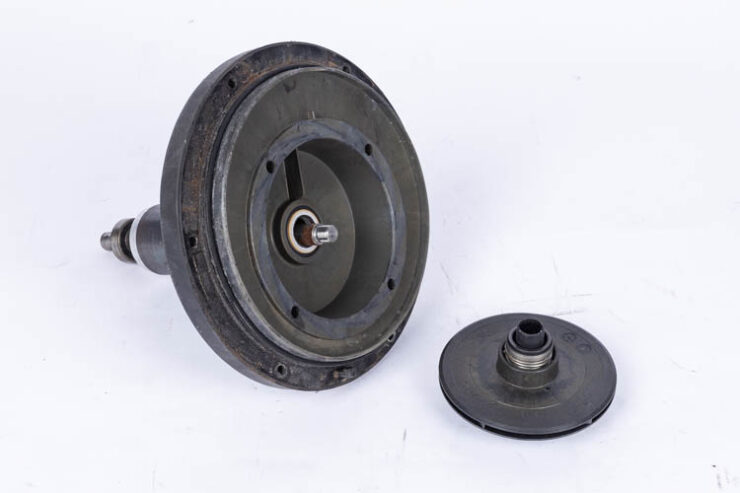
If the bearings get wet, they will rust. Not only will you have a noisy pool pump, but it can also scream and screech like it’s in pain. Bad bearings can eventually lead to a seized pump or a pump motor that trips the circuit breaker due to overload.
Where is the Shaft Seal Located?
The shaft seal comes in 2 or more pieces. One part of the seal is attached to the impeller. The other half of the seal is located in the seal plate. This is the plate that the motor attaches oo and also houses the impeller.
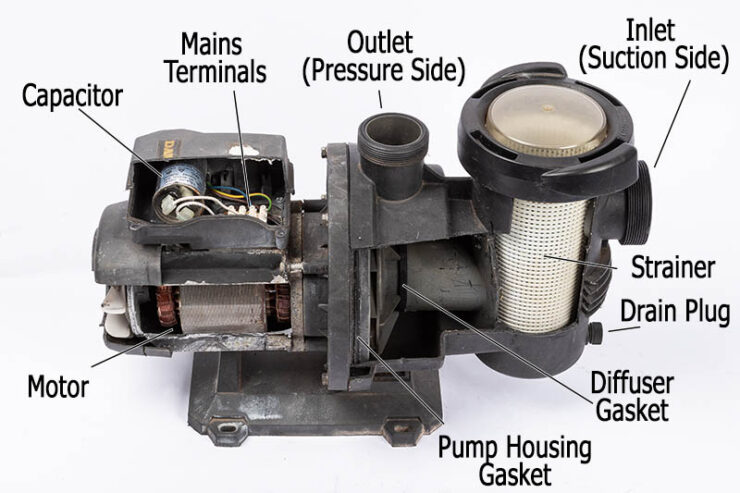
To replace a shaft seal, you’ll need to take the pump apart and remove the impeller. If you are a little handy, you should be able to do this yourself. It’s not that hard.
What Does the Shaft Seal Look Like?
The shaft seal in a pool pump comes as a set. One part of it is attached to the impeller and contains a spring and rubber seal.
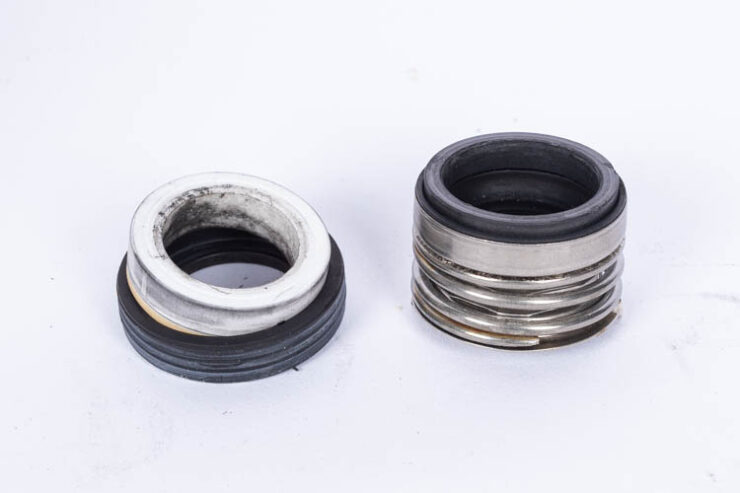
The other part is a ceramic “donut”. Which sits in the pump’s seal plate. The ceramic seal usually has an accompanying rubber seal that goes with it.
Common Signs the Shaft Seal Is Bad
You may be wondering how do you know if the shaft seal or mechanical seal is bad without dismantling your pool pump?
There are three signs you can look out for which indicate that the shaft seal needs replacing:
- Dripping water
- Corrosion on the motor
- Water under the pump
Dripping Water
It’s not always easy to see the water leaking from a pump due to pipes and other equipment getting in the way.
If you can get access to and see the bottom of your pool pump, then you may see water dripping from the motor side of the pump. The water will run out of where the seal plate (plastic part of the pump) and motor meet.
The water will leak when the pump is on and also when it is off.
Calcium or Corrosion on the Motor
A definite sign you have a leak is corrosion on the metal parts of the pump motor.
The metal will turn a white sort of color if this is the case. You’ll often see this on the pump mounting plate or other metal components.
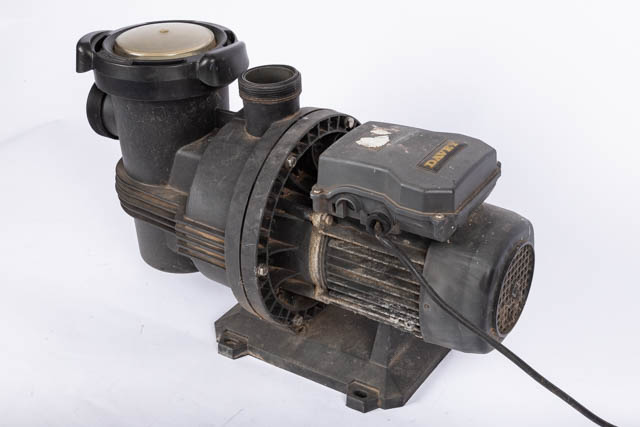
If you notice this, you must fix it immediately or risk seizing up and ruining your pump motor. After all, the cost of a shaft seal is $15 and a bit of time. The cost of a new motor is several hundred dollars.
Water Under the Pump
If you’ve noticed water under your pool pump, this is a sign that the shaft seal is bad. However, it’s not the only reason you may have water dripping and pooling under your pool pump.
Before you go pulling your pool pump apart, you’ll want to rule out that the water is not leaking from the top of the pump or some other place. Common places and reasons water leaks from the top of the pump are:
- Pump lid o-ring
- Damaged, cracked or incorrectly fitted pump lid
- Loose pump lid
- Inlet and outlet unions
If you’ve ruled all of these out, you’ll next want to check the pump’s drain plug too. Water can leak here and run along the bottom of the pump.
The pump housing gasket can also leak water. To fix this one, you’ll need to open up your pump. And if you’re doing that, you may as well change the shaft seal anyway. Since they commonly leak.
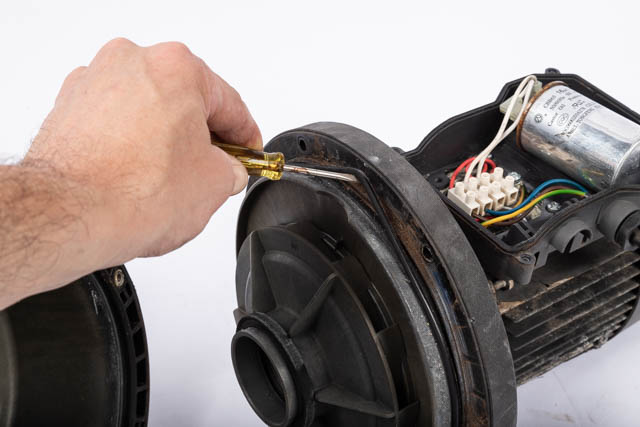
And finally, sometimes the pump housing (the plastic pump assembly that houses the impeller and basket) can crack and leak. Although this isn’t common. You’ll want to check water isn’t leaking here.
Further reading: 12 Reasons Pool Pumps Leak (and How to Fix)
What Causes the Pool Pump Shaft Seal to Leak?
Wear and Tear
All seals and gaskets break down with age. It’s just the way it is. The mechanical seal in your pool pump is normally made of ceramic material and also rubber. Eventually, the rubber will perish and the ceramic material will wear down causing it to leak water.
The average pool pump will rotate over 1.5 million revolutions per day (8 hours of running times 3000 revolutions per minute). That’s 46.5 million rotations per month!
With that much use, no seal will last forever.
Incorrect Installation
“Why is my pump still leaking after changing the pump shaft seal?”
If you’ve just changed your pool pump shaft seal and the pump is still leaking, there are four possible reasons:
- The seal is fitted the wrong way
- The wrong seal was used
- The seal or seal seat was damaged when being installed
- The pump is leaking from somewhere else
The most common reason your pump will still leak is that you’ve fitted the seal backward or replaced it with the wrong part. Take it out, check it’s correct and refit it.
It’s also important to note that the shaft seal is delicate and can be damaged easily. Take care not to score or scratch it when installing.
If you’ve checked all of this, it may be that the pump is leaking from another location. Check the housing seal and also the pump housing for cracks.
Putting Chemicals in the Pump Basket or Skimmer
Adding chemicals in the skimmer or in the pump basket is a big no-no when it comes to proper pool maintenance. These chemicals can damage the rubber seals in pool pumps, pool filters, and unions.
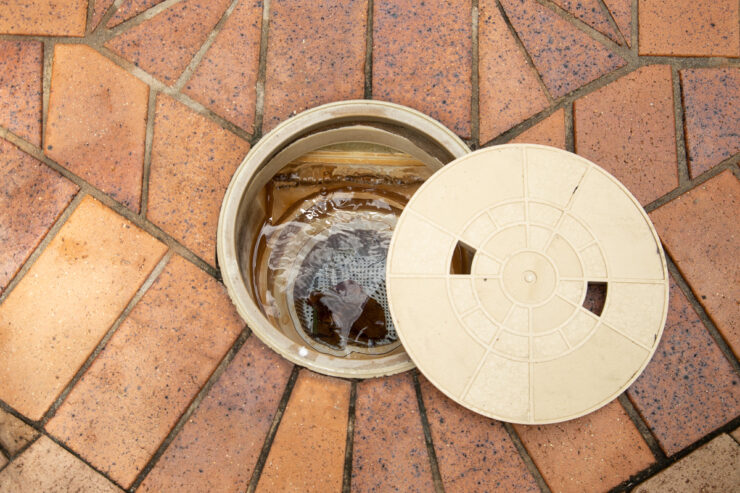
Chlorine and other pool chemicals, such as muriatic or hydrochloric acid, are strong chemicals. Usually, it’s best to dilute these chemicals before adding them to the pool. This will prevent damage to pool equipment and plumbing
Further reading: Should You Add Pool Chemicals to the Skimmer?
Can you Replace a Pool Pump Shaft Seal Yourself?
Replacing a pool pump shaft seal (mechanical seal) can be done at home without any special tools. Anyone who is handy should be able to tackle this job with relative ease.
The hardest part of the job can be getting the impeller off. But with the right know-how, you should be able to do this. You should allow a couple of hours to replace the shaft seal if you’ve never done the job before.
Here’s what’s involved:
- You’ll first, need to remove the pump
- Next, you need to dismantle the pump and remove the impeller.
- Fit the new seals
- Reassemble and replace.
Sometimes impellers get stuck on the shaft. Check out our article with a guaranteed method to remove an impeller that won’t undo.
Cost to Replace a Pump Shaft Seal
The cost to replace a pool pump shaft seal is about $15 for the part if you do it yourself.
For a professional pool technician to do the job, it will likely cost $100 to $200. Labor rates differ across the country, but on average, pool techs charge around $79 per hour.
Related Reading:
Pool Pump Impeller Stuck on The Shaft: How to Remove
How to Remove and Replace Pool Pump Impeller
How Do You Know If Pool Pump Shaft Seal Is Bad?

